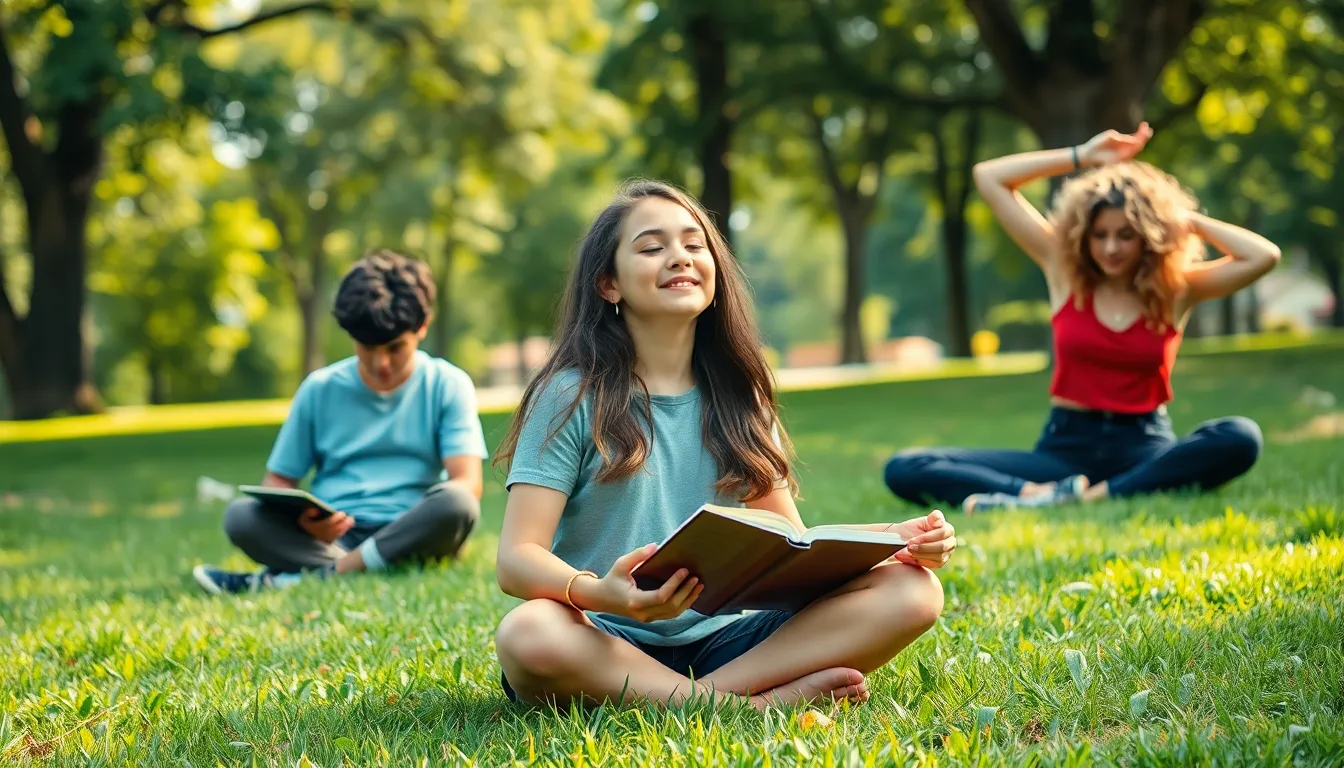In a world buzzing with distractions and drama, teens often find themselves juggling school, social media, and a million other things. It’s no wonder anxiety levels are soaring! Enter mindfulness techniques—think of them as a mental spa day for the brain. These simple practices can help teens hit the pause button, breathe, and reclaim their inner calm amidst the chaos.
Imagine trading in that frantic scrolling for a few moments of zen. Mindfulness can boost focus, reduce stress, and even improve sleep. Plus, it’s a lot cooler than it sounds. With a sprinkle of humor and a dash of practicality, these techniques can transform the daily grind into a more balanced experience. So, why not dive into the world of mindfulness and discover how it can make teenage life a little less hectic and a lot more enjoyable?
Table of Contents
ToggleOverview of Teen Mindfulness Techniques
Mindfulness techniques serve as effective strategies for teenagers navigating daily stressors. These practices empower teens to enhance emotional regulation and increase present-moment awareness. Techniques like deep breathing can shift focus away from anxiety, enabling relaxation.
Meditation stands out as a foundational method. Engaging in short, guided sessions promotes mental clarity and reduces negative thinking patterns. Studies indicate just a few minutes of meditation can significantly lower stress levels.
Body scans represent another useful technique. Teens lie down comfortably and mentally check in with different body parts. This practice fosters a deeper connection between mind and body.
Journaling offers an outlet for self-expression and reflection. Writing thoughts and feelings down can reveal patterns and insights, aiding emotional understanding. Regular journaling may improve overall mental well-being.
Mindful walking engages physical movement while promoting awareness of surroundings. Focusing on the sensations of walking can ground teens, providing a break from overwhelming emotions. This encourages active participation in the environment.
Group mindfulness activities encourage social connection. Participating in mindfulness workshops or classes helps teens develop practices while building supportive relationships. Group settings can provide motivation and encouragement.
Incorporating humor can make mindfulness more relatable. Light-hearted approaches to meditation, like playful mini-sessions, engage teens more effectively. Enjoyable practices enhance the likelihood of regular mindfulness integration.
The overall potency of combining various techniques promotes versatility. Tailoring methods to fit individual preferences can maximize benefits. Accessing mindfulness resources online provides additional support for teens seeking guidance.
Benefits of Mindfulness for Teens

Mindfulness offers significant benefits for teenagers, enhancing their overall mental health and well-being.
Improved Focus and Concentration
Mindfulness techniques boost focus and concentration levels. Practicing deep breathing enables teens to center their thoughts, sharpening their attention. Meditation plays a pivotal role in reducing distractions, allowing students to grasp concepts more effectively. Research shows that mindfulness practices can lead to improved academic performance. Students who engage in mindful activities often report a clearer mindset. Engaging in body scans encourages awareness of thoughts and feelings, promoting mental clarity. Consequently, these practices help teens remain present during classes and study sessions.
Emotional Regulation
Emotional regulation is another key benefit of mindfulness for teens. Mindfulness techniques foster awareness of emotions, enabling teens to identify feelings without judgment. As they practice mindfulness, they learn to manage anxiety and frustration effectively. Journaling serves as a powerful tool for processing emotions, providing an outlet for self-reflection. Through mindful walking, teens connect with their surroundings and gain perspective on their emotional experiences. Group mindfulness activities enhance social awareness and empathy, which are crucial for healthy relationships. By adopting these practices, teens develop resilience and better cope with life’s challenges.
Popular Mindfulness Techniques for Teens
Mindfulness techniques offer various ways for teenagers to cultivate focus and calm. These practices can be easily integrated into their daily routines.
Meditation Practices
Meditation involves focusing attention and eliminating distractions. Guided meditations are particularly effective, as they provide structured prompts that help teens stay engaged. Techniques such as visualization or loving-kindness meditation promote relaxation and self-acceptance. Regular practice leads to enhanced emotional regulation, making it easier for teens to navigate stress. Apps and online resources often offer short sessions tailored for young people, ensuring accessibility.
Breathing Exercises
Breathing exercises serve as quick, effective methods for reducing anxiety. Simple techniques like the 4-7-8 method focus on inhaling for four seconds, holding for seven, and exhaling for eight. This approach calms the nervous system and aids in concentration. Other techniques, such as box breathing, involve inhaling, holding, exhaling, and pausing for equal counts, creating a rhythmic pattern that centers the mind. Incorporating these exercises throughout the day offers immediate relief when stress levels rise.
Journaling and Reflection
Journaling combines self-reflection with emotional processing. Teens can use prompts or free writing to express thoughts and feelings, enhancing self-awareness. Engaging in daily or weekly entries encourages logging daily experiences and emotions. This practice helps identify patterns in thoughts and behaviors, fostering personal growth. An added benefit includes improved writing skills, as regular journaling enhances clarity and expression.
Incorporating Mindfulness into Daily Life
Incorporating mindfulness into daily life helps create a balanced environment for teenagers. Simple practices can fit seamlessly into various routines.
Mindfulness in School Settings
Mindfulness can be integrated into school activities and schedules. Teachers might use short breathing exercises to begin class, providing students a moment to refocus. Group meditations during break times foster a supportive atmosphere, encouraging bonds between peers. Schools can incorporate mindful moments during transitions between subjects to reduce stress and enhance concentration. Regular workshops on mindfulness techniques can empower students to adopt these practices, equipping them with skills to manage academic pressures.
Mindfulness at Home
Home environments play a crucial role in nurturing mindfulness. Families can practice mindful dinners, focusing on communication and presence without distractions. Setting aside time for family yoga or meditation creates shared experiences and encourages deeper connections. Creating a designated quiet space for mindfulness activities promotes consistency in practice. Journaling together as a family can enhance emotional understanding and self-reflection, allowing all members to share and grow. Overall, mindful practices at home help reinforce lessons learned in school, making mindfulness a holistic part of daily life.
Embracing mindfulness techniques can significantly transform a teenager’s experience in today’s demanding world. These practices offer essential tools for navigating stress and anxiety while promoting emotional well-being. By integrating techniques like deep breathing and mindful walking into daily routines, teens can cultivate resilience and enhance their focus.
Moreover engaging in mindfulness not only supports individual growth but also strengthens social connections through group activities. As teens explore these practices, they may find a greater sense of balance and fulfillment in their lives. Ultimately mindfulness serves as a powerful ally in fostering a healthier mindset and enriching the teenage journey.



